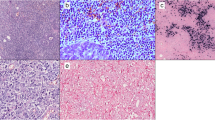Abstract
Titers of transfusion transmitted virus (TTV)-like DNA in saliva samples have been reported 100–1,000 times higher than those of the corresponding sera, suggesting viral transmission by saliva droplets. The present study was conducted to determine whether TTV-like DNA sequence elements play a role in the pathogenesis of cystadenolymphoma or pleomorphic adenoma and if the parotid or the submandibular gland is a major source of TTV persistence. Sixty-two archival salivary gland samples (16 cystadenolymphomas, 13 pleomorphic adenomas, and 33 controls) and 23 corresponding saliva samples were examined using a polymerase chain reaction (PCR) for TTV DNA. All PCR products that displayed DNA bands were sequenced. Leder’s stain and immunohistochemistry (anti-CD8, anti-CD20, anti-CD45R0, anti-CD68, and anti-Ki67/MiB1) were applied to detect possible changes associated with findings of TTV-like DNA sequences. Tissue displayed TTV-like DNA sequences in 8.1% (5/62; saliva: 47.8%, 11/23). Tissue that contained TTV-like DNA sequences was histologically indistinguishable from samples lacking such DNA. TTV appears to be only a bystander in cystadenolymphoma, pleomorphic adenoma, and other salivary gland affections. Neither of the glands seems to be a major source of TTV persistence.

Similar content being viewed by others
References
De Martino M, Moriondo M, Azzari C, Resti M, Galli L, Vierucci A (2000) TT virus infection in human immunodeficiency virus type 1 infected mothers and their infants. J Med Virol 61:347–351
Deng X, Terunuma H, Handema R, Sakamoto M, Kitamura T, Ito M, Akahane Y (2000) Higher prevalence and viral load of TT virus in saliva than in the corresponding serum: another possible transmission route and replication site of TT virus. J Med Virol 62:531–537
Ellis GL, Auclair PL (1996) Tumors of the salivary glands. Armed Forces Institute of Pathology, Washington, ISSN 0160-6344
Fan L, Zhao X, Zhang D, Wang B, Zhang J, Yang D, Hao L (2000) Detection of transfusion transmitted virus in hepatic and extra hepatic tissues using in situ hybridization. Chung Hua Kan Tsang Ping Tsa Chih 8:147–149
Gallian P, Biagini P, Zhong S, Touinssi M, Yeo W, Cantaloube JF, Attoui H, de Micco P, Johnson PJ, de Lamballerie X (2000) TT virus: a study of molecular epidemiology and transmission of genotypes 1, 2 and 3. J Clin Virol 17:43–49
Goto K, Sugiyama K, Ando T, Mizutani F, Terabe K, Tanaka K, Nishiyama M, Wada Y (2000) Detection rates of TT virus DNA in serum of umbilical cord blood, breast milk and saliva. Tohoku J Exp Med 191:203–207
Hasebe C, Kawashima T, Kohgo Y (1999) Histological findings of TTV-positive non-B non-C chronic hepatitis patients. Nippon Rinsho 57:1350–1355
Inami T, Konomi N, Arakawa Y, Abe K (2000) High prevalence of TT virus DNA in human saliva and semen. J Clin Microbiol 38:2407–2408
Jacoby LB, MacCollin M, Louis DN, Mohney T, Rubio MP, Pulaski K, Trofatter JA, Kley N, Seizinger B, Ramesh V, Gusella JF (1994) Exon scanning for mutation of the NF2 gene in schwannomas. Hum Mol Genet 3:413–419
Kazi A, Miyata H, Kurokawa K, Khan MA, Kamahora T, Katamine S, Hino S (2000) High frequency of postnatal transmission of TT virus in infancy. Arch Virol 145:535–540
Lefrere JJ, Roudot-Thoraval F, Lefrere F, Kanfer A, Mariotti M, Lerable J, Thauvin M, Lefevre G, Rouger P, Girot R (2000) Natural history of the TT virus infection through follow-up of TTV DNA-positive multiple-transfused patients. Blood 95:347–351
Matsubara H, Michitaka K, Horiike N, Yano M, Akbar SM, Torisu M, Onji M (2000) Existence of TT virus DNA in extracellular body fluids from normal healthy Japanese subjects. Intervirology 43:16–19
Niel C, Saback FL, Lampe E (2000) Coinfection with multiple TT virus strains belonging to different genotypes is a common event in healthy Brazilian adults. J Clin Microbiol 38:1926–1930
Ross RS, Viazov S, Runde V, Schaefer UW, Roggendorf M (1999) Detection of TT virus DNA in specimens other than blood. J Clin Virol 13:181–184
Sanger F, Nicklen S, Coulsen AR (1977) DNA sequencing with chain-terminating inhibitors. Proc Natl Acad Sci USA 87:7555–7559
Takahashi K, Hoshino H, Ohta Y, Yoshida N, Mishiro S (1998) Very high prevalence of TT virus infection in general population of Japan revealed by a new set of PCR primers. Hepatol Res 12:233–239
Thompson JD, Higgins DG, Gibson TJ (1994) CLUSTAL W: improving the sensitivity of progressive multiple sequence alignment through sequence weighting, positions-specific gap penalties and weight matrix choice. Nucleic Acids Res 22:4673–4680
Wagner M, Muller-Berghaus J, Schroeder R, Sollberg S, Luka J, Leyssens N, Schneider B, Krueger GR (1997) Human herpesvirus-6 (HHV-6)-associated necrotizing encephalitis in Griscelli’s syndrome. J Med Virol 53:306–312
Zuckerman AJ (1999) The acronym TTV. Transfusion transmitted virus. Lancet 353:932
Acknowledgements
We gratefully thank Karl Worm, Uta Dahmen, Mohamed Elewa, and Kai Rispeter for the critical review of the manuscript.
Author information
Authors and Affiliations
Corresponding author
Additional information
An erratum to this article can be found at http://dx.doi.org/10.1007/s00405-006-0135-6
Rights and permissions
About this article
Cite this article
Wagner, M., Klussmann, J.P., Dirsch, O. et al. Low prevalence of transfusion transmitted virus (TTV)-like DNA sequences in cystadenolymphoma and pleomorphic adenoma of the salivary glands. Eur Arch Otorhinolaryngol 263, 759–763 (2006). https://doi.org/10.1007/s00405-006-0052-8
Received:
Accepted:
Published:
Issue Date:
DOI: https://doi.org/10.1007/s00405-006-0052-8




